Diamonds and DORIANS: The Soviet Union’s Almaz and the United States’ Manned Orbiting Laboratory military space stations (part 1)
by Bart Hendrickx and Dwayne A. Day
Monday, December 11, 2023
In the early 1980s, inside a secure US Air Force facility known as the Blue Cube and located not far from the 101 Freeway in Silicon Valley in Northern California, there was a large photograph hanging on a wall. It was in black and white and showed an ungainly-looking spacecraft, a cylinder with solar panels and a conical nose at one end. The vehicle was launched by the Soviet Union and was known as a Transportnyi Korabl Snabzheniya, or Transport Supply Spacecraft—“TKS” for short. The photograph was top secret and had been taken by an American GAMBIT reconnaissance spacecraft, demonstrating its ability to photograph other spacecraft in orbit. The TKS was designed to carry a crew and supplies to a secretive Soviet space station known as Almaz (“diamond”), which itself was equipped with a powerful camera system—and a 23-millimeter cannon that could have blown the GAMBIT out of the sky if it had ever gotten too close. The Cold War was also waged in orbit.
| Both Almaz and MOL failed to demonstrate a viable military role for humans in Earth orbit. |
Almaz was a product of the design bureau led by Vladimir Chelomei, originally called OKB-52 and later renamed TsKBM (1966) and NPO Mashinostroyeniya (1983), the name it still holds today. In many ways, it was a competitor of the OKB-1 design bureau of the famous chief designer Sergei Korolev, which later evolved into what is now known as RKK Energiya. Three Almaz stations were launched under the cover names Salyut-2, Salyut-3, and Salyut-5 in 1973, 1974, and 1976 respectively, creating the impression that they were of the same type as the civilian Salyut stations of Korolev’s design bureau. As would become known much later, the civilian stations (internally designated “Longterm Orbital Station” or DOS) had not been approved until 1970 and were in fact modified versions of Almaz, which traces back its origins to 1964.
While Salyut-2 failed in orbit shortly after launch, Salyuts-3 and 5 hosted a total of three crews, which flew to the stations on Soyuz spacecraft of the Korolev bureau. Chelomei’s own TKS, a 20-ton vehicle about the same size as Almaz itself, ultimately flew only to the civilian Salyut stations and was the forerunner of later space station modules, including the Nauka Multipurpose Laboratory Module, launched to the International Space Station in July 2021.
Although Western observers were aware of the dual nature of the Salyut space stations as early as the 1970s, details about the design and history of Almaz did not begin to emerge from Russian sources until after the collapse of the Soviet Union. This made it possible to obtain a fairly good understanding of the project by the turn of the century.
Our knowledge of the project was significantly expanded with the publication in 2015 of an encyclopedia on Soviet/Russian piloted space projects, which devoted about 70 pages to Almaz. What may be the definitive history of Almaz was written by a team of authors of NPO Mashinostroyeniya and published in 2019. Titled Ogranka Almazov (“The Cutting of Diamonds”), the 500-page book contains a wealth of new information on the project and is lavishly illustrated with never-before-seen pictures and drawings taken from the company’s archives. It does relate the project’s history from the biased perspective of the organization that ran it and does not contain any primary government documents (such as government decrees and ministry orders) that would provide an even deeper insight into Almaz’s objectives, capabilities, and development.
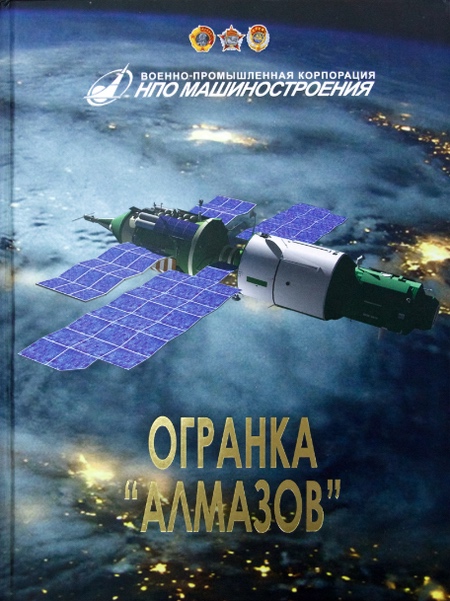 Cover of the book Ogranka Almazov. |
Almaz was the Soviet counterpart to America’s Manned Orbiting Laboratory (MOL). Both were designed as piloted reconnaissance platforms, but unlike Almaz, MOL was canceled in 1969 before a single mission was flown. The National Reconnaissance Office, which was developing the MOL in the 1960s, finally declassified the program in 2015, releasing an official history along with thousands of pages of documents. The NRO later followed this with a history featuring many interviews with the surviving MOL astronauts.
With many aspects of MOL and Almaz now declassified, it has become possible to make a comparison of their objectives, design features, and the reasons for their cancelation. Both Almaz and MOL failed to demonstrate a viable military role for humans in Earth orbit.
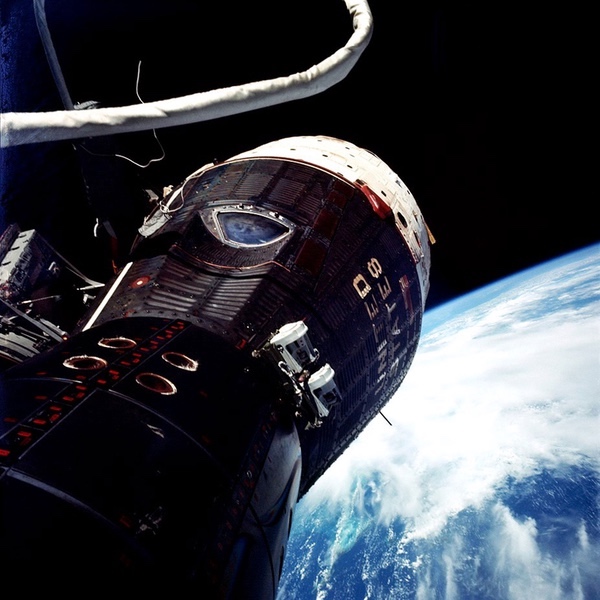 NASA's Gemini spacecraft offered an opportunity for the U.S. Air Force to take advantage of the civilian space agency's investment in a spacecraft that could be adapted for military missions. (credit: NASA) |
Origins and objectives: the US story
Early manned military space projects
The idea of military astronauts operating in space predates the space age by decades. Science fiction stories often depicted space travelers as members of the military, and both the Soviet and American space programs, even while pursuing civil space goals, recruited from military ranks. But it was not obvious even by the early 1960s when astronauts and cosmonauts were orbiting the Earth that there were military space missions that required military astronauts.
The United States Air Force had several programs underway in the early 1960s that were intended to pursue military goals, but their fates highlighted the dilemma of the role of military astronauts.
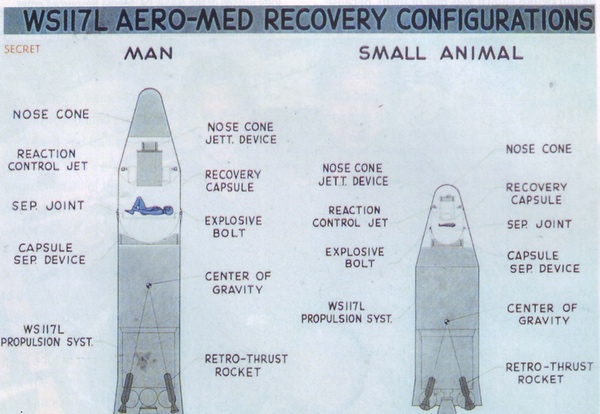 When NASA was created in 1958, the civilian agency was given responsibility for developing human spaceflight, with the U.S. Air Force allowed to investigate any military role for astronauts in orbit. During the late 1950s and early 1960s, the Air Force continued to study its own capsule-type spacecraft, and began development of the pressurized Samos E-5 reconnaissance satellite which could potentially be converted into a manned spacecraft. (credit: NRO) |
The least known and still most mysterious of the military human spaceflight projects was the Samos E-5, which appears to have been initiated by the US Air Force when the service was forbidden from having an astronaut program competing with NASA’s Mercury program. Samos E-5 was a pressurized capsule equipped with a camera system for photographing the Earth. At the end of its mission, the entire spacecraft would return to Earth. The concept was similar to the Soviet Vostok, which also had a camera-carrying variant. At the time, other American reconnaissance spacecraft were not pressurized and did not return their cameras. There are no surviving records directly stating that the Air Force intended to convert the E-5 spacecraft to carry an astronaut, although a declassified official history as well as at least one contemporaneous CIA document both indicate that this was what the Air Force sought to do. Five Samos E-5 spacecraft were launched in 1962, but all failed and the program was canceled.
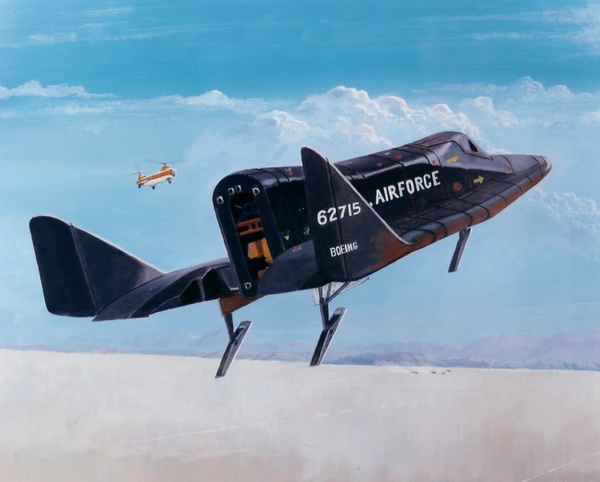 The X-20 Dyna-Soar program was intended to develop a piloted winged spacecraft for the Air Force. Various missions and payloads were proposed for the small spaceplane. The high cost and lack of a clear mission led to its cancellation in late 1963. (credit: USAF) |
The Blue Gemini program was created in 1962 as a limited series of missions that would give the Air Force experience with flying astronauts in space. It grew out of existing NASA and Air Force cooperation on NASA’s Gemini program, which used an Air Force-supplied Titan II rocket. The Blue Gemini proposal was to initially fly joint missions with NASA astronauts on board, then to transition to all-military crews, and possibly to fly one or two missions with a single astronaut and the empty seat occupied by military equipment. But it was unclear exactly what the military astronauts would do other than fly in orbit. The Air Force identified no unique military missions that required a military pilot to perform. Small experiments or military sensors could more easily and cheaply be accommodated on robotic spacecraft. Blue Gemini was canceled the same year that it started. Some Air Force experiments considered for Blue Gemini were transferred to NASA’s Gemini program. Air Force close cooperation with NASA on Gemini provided the service with access to NASA’s experience (see: “A darker shade of blue: The unknown Air Force manned space program,” The Space Review, September 12, 2022.)
| MOL was justified as a project whereby military astronauts would conduct experiments in orbit to determine the utility of astronauts to perform military missions. But at this point, MOL was not really defined. |
The X-20 Dyna Soar spaceplane was canceled in 1963 after numerous proposed operational uses like dropping weapons, attacking other spacecraft, and performing reconnaissance, were considered and rejected, and the experimental mission of demonstrating a winged reentry vehicle could not justify its cost. The Air Force had also been evaluating military Moon bases and a Military Operational Development Station (MODS) in Earth orbit from the late 1950s into the early 1960s, but the MODS name indicated the problem: there were no obvious military missions that required astronauts in space, and they had to be evaluated and developed.
In late 1963, after the cancellation of Dyna Soar, the Air Force began the Manned Orbiting Laboratory program.
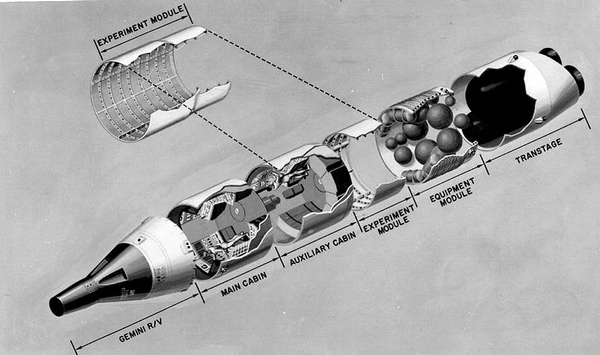 Early concepts for the Manned Orbiting Laboratory implied that it was to perform mostly unclassified research and development missions. But during 1964, the National Reconnaissance Office was sponsoring a series of studies about using MOL to carry powerful optics and perform an operational intelligence collection mission. (credit: NRO) |
Early MOL
In December 1963, the Department of Defense announced the Manned Orbiting Laboratory program. MOL was justified as a project whereby military astronauts would conduct experiments in orbit to determine the utility of astronauts to perform military missions. But at this point, MOL was not really defined. The Air Force began studying several possible military missions that MOL could conduct. These included serving as a command-and-control center, hosting multispectral sensors, and enabling manned assembly of large structures such as antennas. These missions and others were studied throughout 1964, but none of them seemed to coalesce into a clear justification for the orbiting laboratory. Various unclassified artwork of the MOL was produced at this time, and because that artwork became public and was regularly republished, it created a popular impression that MOL was primarily a large pressurized laboratory in which the astronauts worked, rather than what it later became, which was a much smaller pressurized compartment attached to a large unpressurized “mission compartment” containing an optical system.
This phase of endless studies proved frustrating for those in the MOL program office. As one officer explained to another, they had spent most of 1964 trying to move the program “off dead center.”
Around the same time that MOL had been publicly announced, the Director of the National Reconnaissance Office ordered a study of man’s contribution to satellite reconnaissance. This led to an industry survey of manned reconnaissance systems that could fit in a Titan IIIC rocket and studies at Eastman-Kodak from December 1963 to July 1964 of manned reconnaissance systems. In summer 1964, those studies were refined and led to studies of optical systems that could be incorporated into a MOL-sized vehicle. Those “optical system configuration studies” continued into early 1965.
In spring 1964, the NRO created the DORIAN security compartment within the BYEMAN security control system. Only persons with BYEMAN security clearances were allowed to know about reconnaissance systems. DORIAN was a compartment devoted to the study and development of a large optical system for MOL.
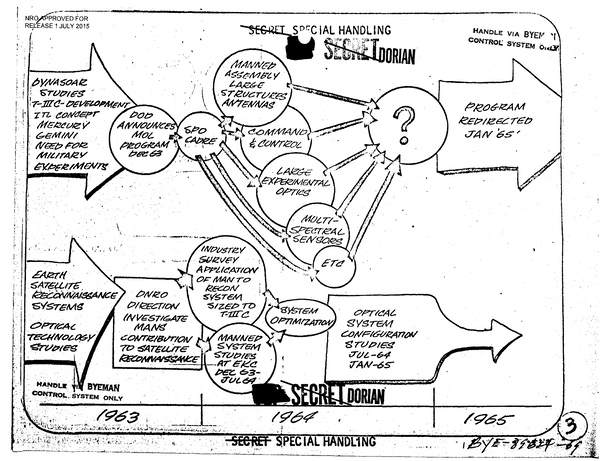 Throughout 1964, various possible military missions were studied for the Manned Orbiting Laboratory, although most of them coalesced around an operational photo-reconnaissance mission. (credit: NRO) |
Later MOL
In January 1965, the MOL program was redirected. Rather than a laboratory containing multiple experiments, the goal became developing MOL into an operational reconnaissance platform that would produce intelligence to be used by national-level leadership, meaning the President, the Secretary of Defense and senior Pentagon leadership, and the Central Intelligence Agency and other relevant intelligence agencies. The optical system for MOL was named DORIAN, a name that was never to be spoken or transmitted outside of secure facilities. After the MOL program was declassified, one MOL astronaut remembered that the general in charge of the program had a female secretary named “Dorian,” and the astronaut used to flinch whenever the general would yell for her to come into his office.
Although MOL retained its “laboratory” name, by 1965 MOL was intended to support a large optical system that astronauts would use to photograph the Soviet Union at high resolution. The United States already operated robotic reconnaissance satellites, but MOL was intended both to take photographs at higher resolution than any of them and to avoid their deficiencies. It was assumed that astronauts could improve image focus and operations, fix malfunctions, and photograph “targets of opportunity” including finding gaps in cloud cover over reconnaissance targets such as Moscow. A major justification for including astronauts in MOL was that the small field of view of the powerful optical system required an astronaut to accurately point it at the targets. Another justification, soon abandoned, was that astronauts were needed to assure the reliability of the electronic systems on the spacecraft. But rapidly improving electronic systems soon made this unnecessary.
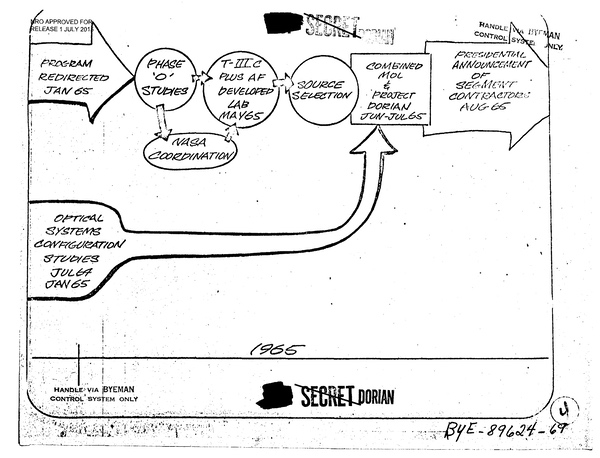 Throughout the first half of 1965, MOL became better defined as an operational reconnaissance satellite, leading to eventual presidential authorization of the program in August. (credit: NRO) |
NRO reconnaissance satellites had been plagued by clouds early in their operations, with some missions returning photographs that were 50% cloud cover. But by the early 1960s the NRO began operating its own series of meteorological satellites to determine cloud cover over Soviet targets before the film satellites made their passes over those targets. The meteorological satellites could provide data to enable ground controllers to command the satellites to not take photos. The MOL DORIAN system would have such a small field of view that a human operator could be useful for avoiding small patches of clouds, but this requirement indicated an inherent dilemma for MOL: the value of the astronauts was very limited and specific.
Although MOL evolved throughout 1964 and into 1965, it was not until August 1965 that the program received presidential approval, a key factor in obtaining budgeting for full-scale development. The publicly released estimate was that MOL would cost $1.5 billion. At that point, MOL transitioned from “Pre-Phase I” to “Phase I”—the phase where MOL would start getting expensive.
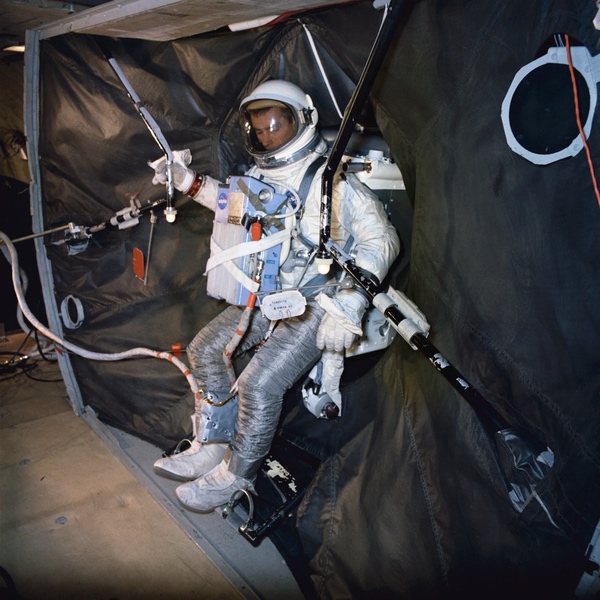 The Astronaut Mobility Unit was originally an Air Force project but was transferred to NASA for testing, indicating one of the dilemmas for any military space program--much research and development could be handled by the civilian space agency. The AMU was flown on a Gemini mission, but was unable to be tested. (credit: NASA) |
Part of the problem for manned military space programs in the United States was that NASA already existed, was active, highly public, and well-funded. This had practical and ideological effects. With NASA performing many different experiments and missions involving astronauts, there were fewer activities for military astronauts to perform, and many opportunities to shift the work to NASA. Between March 1965 and November 1966—a period of 20 months—NASA launched ten Gemini missions. The agency gained significant experience within a short period of time and developed hardware with each mission. Gemini 9, for instance, launched in June 1966 and included the Air Force’s Astronaut Maneuvering Unit. Although the AMU was not able to be tested on this mission, it demonstrated that if NASA could perform a test flight, the military did not have to. This also created political pressure as well. At one point during the MOL program, the Air Force faced uncomfortable questions from Congress about why they needed to launch from California when there were already existing facilities in Florida. Military astronaut programs had a harder time justifying their existence in an openly public and political environment.
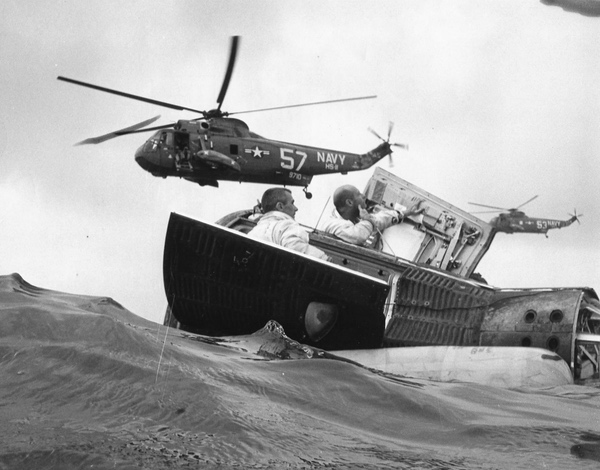 NASA flew ten Gemini missions within a very short period of time, developing new technology and operational concepts that the Air Force could take advantage of. Here the Gemini 9 crew is being recovered after their mission. (credit: US Navy) |
After presidential approval, the MOL program started contract definition from October 1965 to May 1966. Proposal evaluations took place from June to September 1966. Contract negotiations occurred from July to December 1966. But in January 1967 it became apparent that the funding needs exceeded the budget, prompting a schedule adjustment. By mid-1967, the program had direction to proceed on a new schedule and baseline allocation of funds for fiscal year 1968, which started in July 1967. (At the time, the US government's fiscal year ran from July to June. Later it would start on October 1.)
Douglas Aircraft Company was the prime contractor for the laboratory. Eastman-Kodak was the contractor for the powerful DORIAN optical system (the contract was secret.) McDonnell Aircraft Corporation was the prime contractor for the Gemini B spacecraft. General Electric was responsible for major subsystems. Many of the major contractors built substantial new infrastructure to support MOL. Douglas built a new building in California for major structural assembly of the laboratory. Eastman-Kodak built a large building in Rochester, New York, with new fabrication and testing equipment to handle the big optical systems.
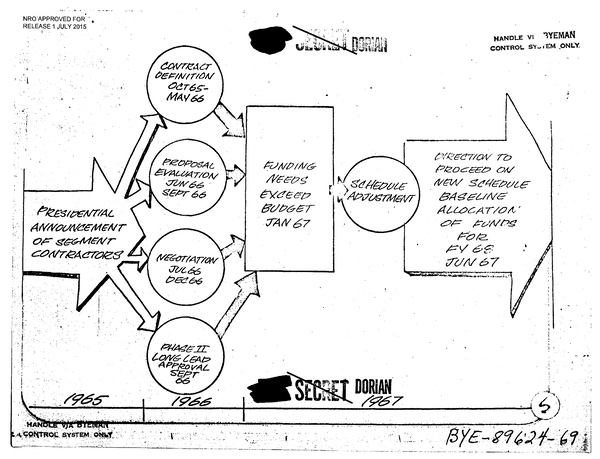 Once MOL received high-level approval, the Air Force and National Reconnaissance Office began issuing contracts with aerospace companies to develop MOL hardware. But it quickly became apparent that the program’s costs were much higher than initially planned and the program’s schedule had to be adjusted. (credit: NRO) |
Douglas selected four major subcontractors: Hamilton-Standard for environmental control and life support, Collins Radio for communications, Honeywell for attitude control, and Pratt & Whitney for electrical power. Although Douglas selected IBM for data management, the Air Force objected based upon their high cost compared to UNIVAC, and Douglas therefore signed study contracts with both firms. The Aerospace Corporation was given responsibility for general systems engineering and technical direction, a role that it played for many Air Force missile and space programs.
| The optical system for MOL was named DORIAN, a name that was never to be spoken or transmitted outside of secure facilities. After the MOL program was declassified, one MOL astronaut remembered that the general in charge of the program had a female secretary named “Dorian,” and the astronaut used to flinch whenever the general would yell for her to come into his office. |
The MOL would be launched on top of a powerful new booster designated the Titan IIIM. It would require a new launch pad at Vandenberg Air Force Base in California. Using eminent domain, the government seized property to the south of the existing base from the wealthy Sudden family, which owned farm and ranching lands along significant portions of the California coast. The Air Force then began construction of Space Launch Complex-6 on the property. The land seizure resulted in a lawsuit by the Sudden family and the Air Force was later forced to pay more for the seized property than it initially proffered.
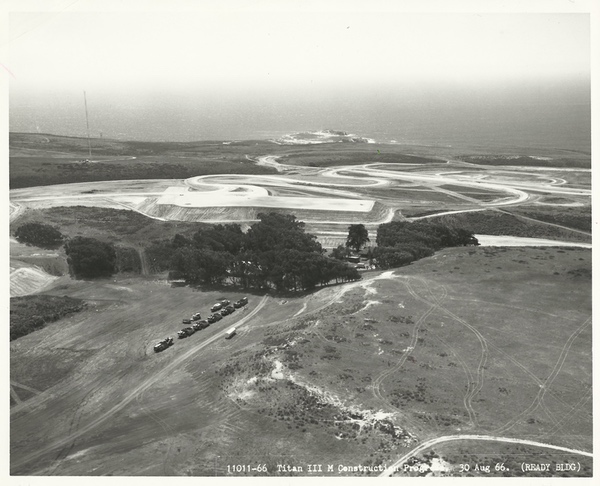 At Vandenberg Air Force Base on California's central coast, a large area known as Sudden Ranch was seized from the Sudden Family using eminent domain. This area was needed for construction of the MOL launch pad, known as Space Launch Complex-6. The Sudden Family challenged the seizure in court, claiming that the government underpaid for the land, and was awarded additional money. (credit: Joe Page) |
Space Launch Complex-6, also known as SLC-6 or “Slick Six,” required the clearing and preparation of a substantial amount of area nestled between low mountains and the coast. After the area was cleared, a concrete foundation and flame ducts were constructed, and the launch and support structures were started.
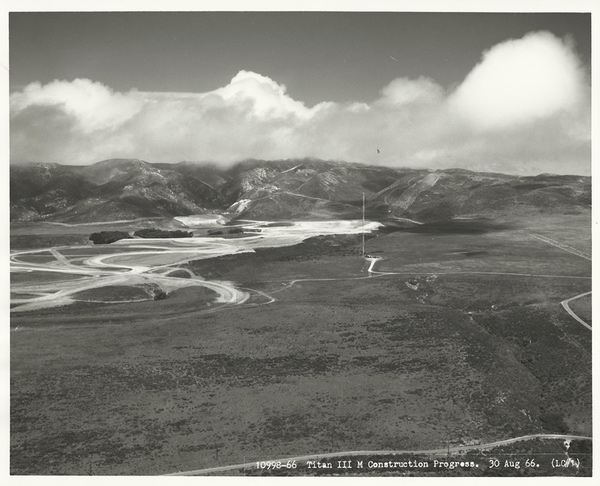 Space Launch Complex-6 was one of the largest construction projects at Vandenberg. The complex had to support both the Titan IIIM rocket--the most powerful planned for Vandenberg—as well as the MOL and Gemini payloads and astronaut activities. (credit: Joe Page) |
Astronaut selection
While the MOL program started selecting contractors, signing contracts, and beginning the early stages of program development, the Air Force also selected its first group of MOL astronauts and announced them on November 12, 1965. Two more MOL astronaut groups were selected, in June 1966 and June 1967. Once they were selected for the program, the MOL astronauts were immediately briefed on its mission, as well as shown the results of other space intelligence programs. For most of them, this was their first exposure to a highly classified world of space-based reconnaissance that they were completely unfamiliar with.
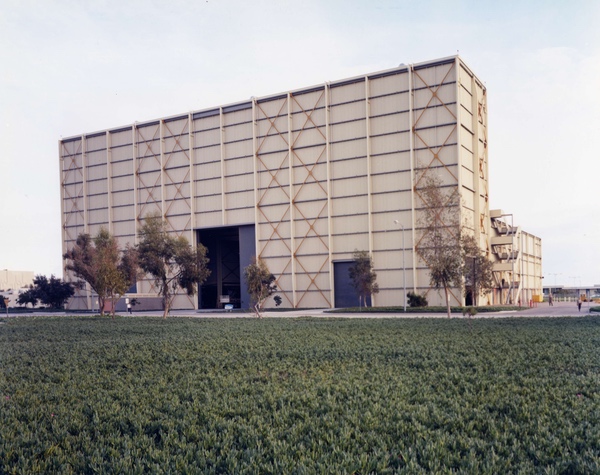 The Manned Orbiting Laboratory program required the construction of substantial new infrastructure, such as this processing building for Douglas in California. (credit: NRO) |
Origins and objectives: the Soviet story
Early manned military space projects
The Soviet space program lacked the clear dichotomy between civilian and military space projects that existed in the United States after the formation of NASA in 1958. As a result, the piloted and military space programs were closely intertwined from the very beginning. Vostok, the country’s first crewed spacecraft (built by Sergei Korolev’s OKB-1 bureau), was in fact a piloted version of an identically named automatic reconnaissance satellite, which was renamed Zenit after the name Vostok became public knowledge with the launch of Yuri Gagarin in April 1961. Tellingly, the government decree that sanctioned Vostok in May 1959 mentioned the piloted aspect of the project only in its supplements. As has become clear from declassified documents in recent years, an important initial objective of the crewed Vostok project was to demonstrate the value of having military persons in orbit, although none of the missions that were eventually flown had any unambiguous military objectives.
Like the United States, the Soviet Union studied piloted spaceplanes that would be used for missions such as satellite inspection and negation. That work continued even after the cancelation of Dyna-Soar in 1963. An air-launched spaceplane called Spiral was approved in 1966 and reached the stage of atmospheric drop tests in the 1970s before it was superseded by Buran, the counterpart to America’s Space Shuttle. Even Buran itself was primarily seen as a response to the perceived military threat posed by the Space Shuttle. (See “Target Moscow: Soviet suspicions about the military uses of the American Space Shuttle (part 1)” The Space Review, January 27, 2020; and “Target Moscow: Soviet suspicions about the military uses of the American Space Shuttle (part 2)” The Space Review, February 3, 2020.)
At Korolev’s OKB-1 bureau, plans for dedicated military piloted spacecraft emerged in 1962–1963 as part of the Soyuz project, which at the time was aimed at assembling spacecraft in Earth orbit for a wide variety of purposes. Two vehicles that appeared on the drawing boards were 7K-P for satellite inspection and 7K-R for reconnaissance (7K was the industry designator for Soyuz.) The work was soon transferred to OKB-1’s Branch number 3 in Kuibyshev (now called Samara), headed by Dmitri Kozlov. This had already taken over the production and further design of the Zenit spy satellites from OKB-1’s central bureau and would go on to hold a virtual monopoly in the field of optical reconnaissance satellites (it is now known as the Progress Rocket and Space Center.)
One audacious plan for the 7K-P missions was for one of the crew members to perform a spacewalk to the enemy satellite and attach explosives to it. Another version of the spacecraft, named 7K-PPK, would be equipped with eight space-to-space missiles to knock out enemy targets. However, plans for manned ASAT platforms were not long-lived as attention turned to doing the same job with unmanned interceptors.
| One audacious plan for the 7K-P missions was for one of the crew members to perform a spacewalk to the enemy satellite and attach explosives to it. |
By 1965 the only surviving project was the reconnaissance vehicle (7K-R or Soyuz-R), essentially a small Soyuz-based space station that would be visited by Soyuz spacecraft. Later that year it morphed into 7K-VI (“VI” standing for voyenno-issledovatelskiy, meaning “military research”). Also known as Zvezda (“Star”), this was designed to carry two cosmonauts on one-month missions. By early 1967, it had significantly evolved from the basic Soyuz design, with the reentry capsule mounted on top of a cylindrically shaped work compartment, making it look somewhat like a small version of MOL. Like MOL, it would have been launched with the crew on board and cosmonauts would have entered the work compartment via a hatch in the heat shield. On-board systems would draw power from radioisotope generators rather than solar panels. In contrast to Almaz, very little is known about 7K-VI. Almost all the available information on it stems from a series of articles published in the Russian space magazine Novosti Kosmonavtiki in 1997.
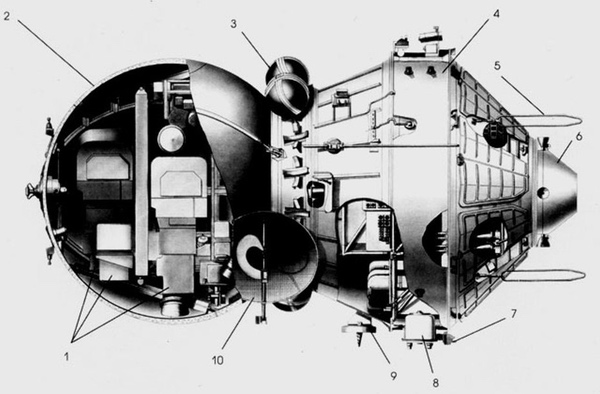 The Vostok look-alike Zenit-2 reconnaissance satellite. (credit: RKK Energiya) |
The origins and objectives of Almaz
The initiative to develop a much larger military space station came from the OKB-52 design bureau of Vladimir Chelomei. Having initially specialized in anti-ship cruise missiles, it branched out into intercontinental ballistic missiles, space launch vehicles, and military satellites in the late 1950s and early 1960s. Among the projects it worked on were the UR-500/Proton rocket (originally conceived as an ICBM), ocean reconnaissance and early warning satellites, as well as anti-satellite systems.
The roots of Almaz go back to 1964, but even the new publications on Almaz remain vague on its origins. Like earlier sources, they trace back the start of the project to October 12, 1964, when Chelomei convened a meeting at his design bureau to announce the goal of building a big 20-ton piloted reconnaissance platform to be launched by his design bureau’s powerful Proton rocket, a two-stage version of which would make its debut in July 1965 (Almaz required a three-stage version.) Obviously, Chelomei did not come up with the idea overnight, but nobody seems to know or remember what had led him to make this proposal or even if Almaz was his own brainchild. It is tempting to believe that Chelomei’s main source of inspiration had been MOL, but there is no hard evidence to back up that claim. The 2019 history of Almaz does reveal that by early 1966, both 7K-VI and Almaz had been included in “a five-year plan for the development of space systems.” This was possibly a reference to a five-year plan for space-based reconnaissance systems known to have been signed by Minister of Defense Rodion Malinovski on June 18, 1964.
Even though Almaz may have been high on Chelomei’s wish list, the project’s final approval was far from a done deal. Just two days after the October meeting, Soviet leader Nikita Khrushchev was overthrown and replaced by Leonid Brezhnev. Khrushchev had been a strong supporter of Chelomei, at least in part because his own son (Sergei Khrushchev) worked for the design bureau. With Khrushchev gone, Chelomei found himself fighting for the survival of many of his space and missile projects. In October 1965, the Ministry of General Machine Building, set up in March 1965 to co-ordinate Soviet space and missile projects, did allow OKB-52 to work out a preliminary design for both Almaz (then simply called Orbital Piloted Station or OPS) as well as a piloted “inspector/interceptor” vehicle (abbreviated PP), probably an outgrowth of a military spaceplane (Raketoplan) that the bureau had earlier worked on.
OPS was high on the agenda during a critical meeting at the Ministry of General Machine Building in January 1966. Various accounts have been given of this meeting, but according to the 2019 Almaz history, its main purpose was to decide who would build OPS. Some were in favor of relegating OKB-52’s role in the space program to testing hardware developed by other design bureaus and assigning both 7K-VI and Almaz to OKB-1’s Branch nr. 3, meaning that the preliminary design of Almaz that had already appeared by that time was not yet set in stone. Chelomei reportedly fended off the attacks against his design bureau by saying that a quick response was needed to America’s MOL and that the already overtaxed OKB-1 would be hardly capable of coping with that task. This is the only known reference that Chelomei ever made to MOL.
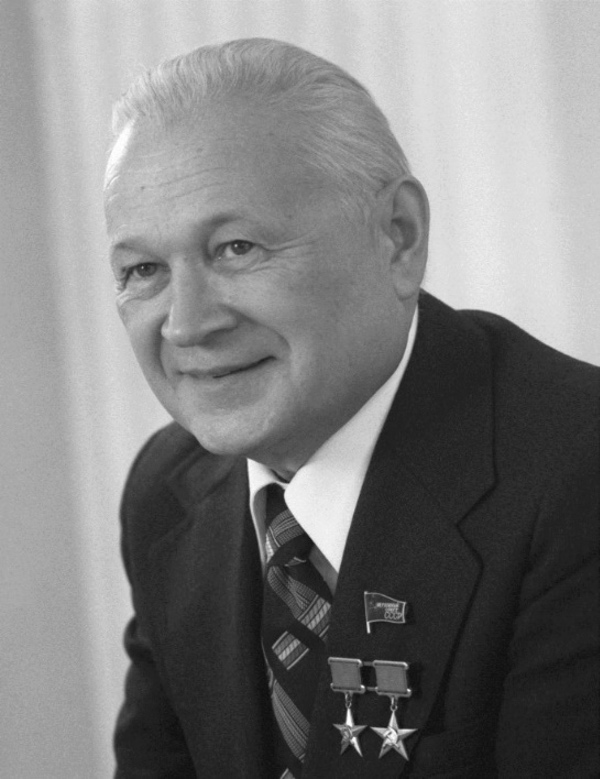 Vladimir Chelomei |
The consensus reached at the meeting was that Almaz should be developed by Chelomei’s bureau, but that OKB-1 Branch nr. 3 would have to design a transport vehicle for the station derived from 7K-VI. This decision was consolidated by a Communist Party and government decree of July 21, 1966, which officially named Chelomei’s bureau as the prime contractor for Almaz and opened up funding for the project. This can be considered the real start date of the project, nearly one year after MOL received presidential approval.
The available information suggests that 7K-VI and Almaz were not competitors, but two projects that had their own well-defined goals and were both considered worth carrying out. One piece of evidence pointing in that direction is the fact that two separate teams of cosmonauts trained for the two projects simultaneously. Russian sources have shed little light on the motives for having two different piloted military space systems. What is obvious, though, is that the Soyuz-based vehicle (weighing just under seven tons) had much more limited capabilities than the 20-ton Almaz. As the name “VI” itself implies, it seems to have been intended mainly for military research, whereas Almaz was seen as an operational reconnaissance platform. In a way, 7K-VI would perform the research role that was originally envisaged for MOL, while Almaz would do the operational reconnaissance work that became the ultimate goal of MOL.
Little has been revealed about the kind of work that would be done aboard 7K-VI. Cosmonauts would have used an optical visor to look for interesting targets and subsequently photographed them with an onboard camera. One experiment known to have been prepared for 7K-VI had the name Svinets (“lead”) and was aimed at observing Soviet missile launches with an experimental infrared detector that could later be modified for installation aboard early warning satellites (the experiment was eventually performed by the crew of Soyuz-6 in 1969.) 7K-VI also had a limited electronic intelligence capability and would have carried equipment to defend it from ASAT attacks.
As has become clear from the newly published information, Almaz was initially conceived as a versatile reconnaissance platform that would carry not only optical instruments, but also radar, infrared, and signals intelligence payloads. As stipulated in the June 1966 decree, Almaz was to conduct “detailed all-round reconnaissance of particularly important small-size and partially concealed strategic objects with a resolution of 0.5 to 1.0 m” during missions lasting one to two years.
Among the objects of interest were launch sites of ICBMs and space launch vehicles, airfields for strategic bombers, naval bases, anti-missile and counterspace detection and targeting systems, communication facilities, military-industrial installations, and storage facilities. Also included in the objectives were “the study of methods for the military use of space assets during long-duration missions of up to six months” as well as biomedical research (presumably linked to the long-duration missions.) This indicates that Almaz also had non-military goals, which may be explained by the fact that there were no serious plans at the time for civilian space stations. Since OKB-1 was preoccupied with Voskhod, Soyuz, and the piloted lunar program, its space station work had remained limited to paper studies, making it easier for OKB-52 to fill the space station niche.
| In short, Almaz could do the same job as a whole bunch of military satellites taken together. In addition to all that, the cosmonauts could also do repair and maintenance work if required. |
Almaz was expected to vastly expand the capabilities offered by Soviet military satellites in the 1960s. The Vostok look-alike Zenit reconnaissance satellites carried traditional refractor (glass lens) camera systems with limited focal lengths. Moreover, they could stay in orbit for only one to two weeks, requiring a massive number of launches to provide continuous coverage of critical areas. None of the pictures could be sent back to Earth in real time, meaning that critical imagery would take days to reach photo interpreters. On top of that, many of the pictures returned by the satellites showed only cloud cover, rendering them useless. Unlike the United States, the Soviet Union did not have dedicated military weather satellites to help the reconnaissance satellites obtain cloud-free pictures.
Almaz could address all of these problems. Its sheer size enabled it to carry large catadioptric imaging systems (using both lenses and mirrors) with long focal lengths that did not fit inside the crammed Zenit descent capsule and would offer a resolution of one meter or better. Unlike Zenit, a single Almaz could stay in orbit for weeks or months and imagery could regularly be sent to the ground in film return capsules or sent back to Earth (at lower resolution) in real time using a photo readout system. Cosmonauts could look for interesting targets and spot cloud cover in advance to make sure that no precious film was wasted while flying over these regions. If necessary, the on-board infrared and radar systems could be used to peer through the clouds. In short, Almaz could do the same job as a whole bunch of military satellites taken together. In addition to all that, the cosmonauts could also do repair and maintenance work if required. The presence of cosmonauts not only increased the flexibility of the station but was simply necessary because all these operations could hardly be automated with the technology available in the 1960s.
Kozlov’s 7K-VI project seems to have survived until early 1968, but the reasons for its cancelation remain vague. Judging from the diaries of cosmonaut training chief General Nikolai Kamanin, there was much opposition against it from Vasili Mishin, who had succeeded Sergei Korolev after the latter’s death in January 1966. Instead of 7K-VI, Mishin proposed a small Soyuz-based space station (Soyuz-VI) that harked back to the 1963 Soyuz-R design, but that was abandoned as well in 1970 after the approval of the civilian Salyut space stations. A crew ferry that was designed for Soyuz-VI did later evolve into the three-man Soyuz-T spacecraft, which flew 15 missions to Salyut-6, Salyut-7, and Mir in 1980–1986.
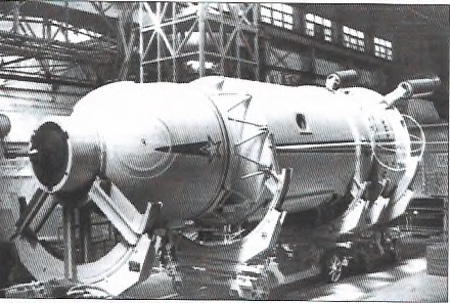 Mockup of the 7K-VI Zvezda spacecraft. (credit: Novosti Kosmonavtiki) |
Cosmonaut selection
Cosmonaut teams for both 7K-VI/Zvezda and Almaz were selected in September 1966. The Almaz team initially consisted of just five members, headed by Voskhod-2 veteran Pavel Belyayev, but was gradually expanded during the following years. After the definitive cancelation of Soyuz-VI, trainees for that project were transferred to the Almaz group in August 1970. By 1971 the Almaz cosmonaut team, now led by Vostok-4 veteran Pavel Popovich, numbered 28 members, making it the largest training group in the Soviet cosmonaut corps at the time. The expectation was that once the project reached operational status, several Almaz stations would orbit the Earth simultaneously, requiring a large pool of cosmonauts to draw from. Ultimately, only six cosmonauts of the Almaz team would go on to fly aboard the stations.
Next: MOL and Almaz enter active development.
No comments:
Post a Comment